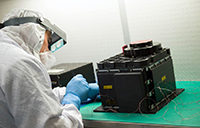Michael Daly, a York University researcher, is the lead scientist on a laser altimeter that will map the surface and create a 3D model of the asteroid Bennu during a NASA mission launching in 2016.


The instrument will also help to guide the spacecraft on the OSIRIS-REx Asteroid Sample Return Mission to a safe spot, where it will grab a sample to bring back to Earth.
“From a science perspective, we need to understand the current state and the evolution of the asteroid,” said Daly, a Lassonde School of Engineering professor, noting one of the goals of the mission is to understand the organic material content of asteroids.
“The sample will provide a snapshot of materials available during the formation of the solar system.”
By contributing the instrument – the OSIRIS-REx Laser Altimeter (OLA), an advanced LIDAR (Light Detection And Ranging) – to the mission, Canada will get a portion of that sample. The mission is expected to return 60 grams of the asteroid, but more than a kilogram is hoped for. It will provide Canadian scientists the first-ever direct access to a pristine asteroid sample, according to the Canadian Space Agency (CSA), which funded the instrument.
OLA is more accurate and has a higher resolution than previous altimeters that have been aboard any previous planetary missions, which means better mapping of the asteroid’s topography.
“A lot of LIDARs stare straight and depend on the spacecraft to move around and provide mapping, but we actually do a raster scan, like the way an old cathode-ray tube TV works,” said Daly. “It’s more like taking a range picture than getting a single measurement. The fidelity of information will be higher.”
Bennu, which is about 500 metres in diameter, is of particular interest because it is one of the most potentially hazardous asteroids presently identified, with a small chance of hitting Earth in the 22nd century. The mission will allow the team to study and track the asteroid’s orbit, as OLA will provide precise distance measurements from the spacecraft to the rocky surface.

“That’s important, as an asteroid’s orbit is difficult to predict over the long term; because asteroids are so small, they get pushed around by small forces,” said Daly. “Understanding how this asteroid has been pushed around, along with its surface and shape properties, will help us to track asteroids better in the future. And thereby we can provide improved predictions about probability of collisions with the Earth.”
OLA, about the size of two bread boxes, will also help navigate the spacecraft to the best location for grabbing a sample. But that won’t happen for a while.
“The main part of the mission, the proximity operation, starts seven or eight kilometres from the asteroid,” said Daly. “Then, it’s a long process of getting to know the asteroid well enough and its non-uniform gravity field well enough to be able to get down and touch the surface and grab a sample.”
That phase will start in late 2018.
As the prime contractor for the CSA, MacDonald, Dettwiler & Associates (MDA), together with its industrial partner Optech, designed, built and tested the instrument.
York University’s Daly is the lead instrument scientist for OLA. The team also includes professors Alan Hildebrand, University of Calgary; Ed Cloutis, University of Winnipeg; Rebecca Ghent, University of Toronto; and Catherine Johnson, University of British Columbia.
Recently delivered to Lockheed Martin in Denver, OLA will now be integrated with the NASA spacecraft for launch in September.


